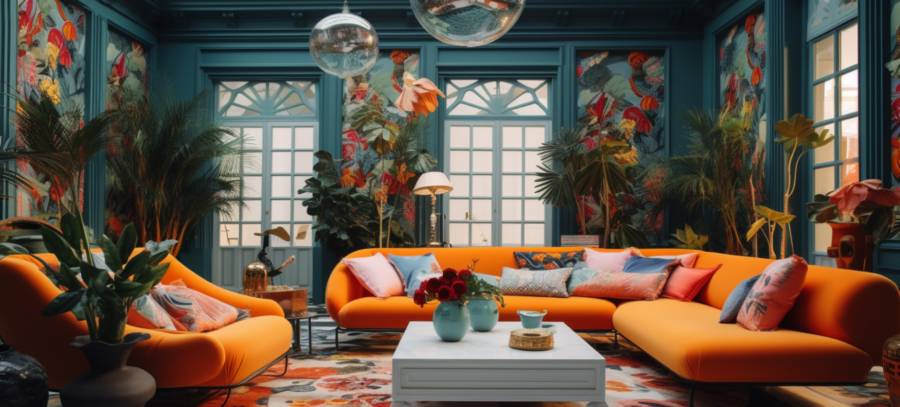Interior Design: Maximalism in the Age of Minimalism

A Rebellious Expansion
Imagine, for a moment, a world of unending beige walls, monochromatic color schemes, and blank spaces reflecting an aura of emptiness. Now, imagine the antithesis: walls adorned with wild patterns, rooms filled with eclectic furnishings, and colors colliding in an unapologetic display of vibrancy. Welcome to the world of maximalist interior design, the flagrant sibling of the minimalist movement, which has reared its extravagant head in retaliation to the Scandinavian-inspired obsession with minimalism that has permeated our lives in recent years.The Tenets of Maximalist Interior Design
Maximalism celebrates the messy joy of life in all its cluttered splendor. It is a style that unabashedly blends colors, patterns, textures, and materials with no concern for matching, resulting in spaces that feel personal, lived-in, and most importantly, alive. Here are some key principles to grasp if you're considering an adventure into this realm of unbounded creativity:1. Color Chaos
Where minimalism calls for muted tones and limited palettes, maximalism gleefully embraces the full spectrum of color. Combine bright shades with darker hues, throw in some metallic accents, and dabble in a few daring pairings that would make a minimalist quake in their white sneakers.2. Pattern Pandemonium
Maximalism revels in the chaotic mingling of patterns. Florals wage war with stripes, animal prints lurk between chevrons, and damasks lock horns with geometric shapes. The key is to find harmony within the disarray, tying the space together with shared colors and varying scale.3. Texture Extravaganza
A crucial component of maximalist design is the layering of textures. Delight in the contrast of plush velvet against the cool, hard surface of a marble tabletop, or lose yourself in the warm embrace of a faux fur blanket draped over an intricately carved wooden chair. The more tactile interest you create, the more inviting the space will feel.4. Material Medley
Maximalism encourages the amalgamation of materials, from the rustic charm of reclaimed wood to the sleek, modern allure of polished metal. Combining different materials and finishes within the same space results in a stimulating environment that keeps the eye engaged and the senses invigorated.The Art of Balance
While maximalism revels in the wild abandon of design conventions, there is still a semblance of order to be found within the chaos. Balance is key to creating a space that is visually captivating, without becoming overwhelming. Consider these guidelines to achieve a harmonious maximalist space:- Play with scale: Intersperse smaller patterns and objects among larger ones to create a sense of depth and prevent the space from feeling cluttered.
- Create focal points: Determine the areas you want to emphasize and build visual interest around them, allowing other areas to play supporting roles.
- Edit thoughtfully: Though maximalism embraces the inclusion of numerous design elements, it doesn't mean filling a space with every single item that sparks joy. Select your most cherished pieces and display them proudly, leaving some breathing room for the eye to rest.
Maximalism: The Antidote to Minimalism?
In a world that often feels sterile and impersonal, the maximalist movement can be seen as a necessary reaction to the pervasive influence of minimalism in design. It is a celebration of individuality, self-expression, and the beauty of imperfection.However, maximalism is not for the faint of heart. It requires a certain level of courage, a willingness to let go of preconceived notions of order and tidiness, and the ability to embrace the inherent chaos of life. If you're willing to break free from the confines of minimalism and dive headfirst into the wondrously eclectic world of maximalist interior design, you just might find yourself reveling in the joyous cacophony that is life, unfiltered.
Article kindly provided by designerviews.org
Latest Articles
- Why Your Product Photos Should Tell a Story
- Crafting Interiors That Help Music Truly Come Alive
- Why Packaging Design Matters Even for Digital Products
- Color Palettes That Evolve: Creating Schemes That Shift With Time of Day, Mood, or User Context
- Exploring Subtle Details Found in Quality Swiss Timepieces
- How Adaptive Cabin Environments Let Chauffeured Executives Shift Effortlessly Between Rest and Focus
- Jewellery as Identity Encryption: Choosing Symbols That Speak Only to You
- From Minimal to Maximal: Print Styles That Actually Fit Your Decor
- From Cathedrals to Conference Halls: How Venue Acoustics Change the Meaning of Music
- How to Photograph Big Celebrations Without Interrupting the Flow
- Selecting an SEO Company When Your Business is Design-Driven: What Creative Agencies Should Know
- Unexpected Light Sources That Make Photographers Look Clever
- Understanding the Emotional Grammar of Portrait Light
- Why the Humble Photo Booth is the Secret Glue of a Wedding Day
- Hues That Hug: Creating Calm, Focus, and Joy Through Sensory Colour
- How Monochrome Shifts Perception in Wildlife and Landscape Imagery
- Color Grading Secrets That Make It Look Like You Had a Lighting Crew
- Photography: Blending Environmental Portraiture Into Ordinary Home Spaces
- Charity Comm's Greatest Hits and How to Actually Fix Them
- Pop-Up Studio on the Move Makes Mobile Portrait Setups Work Anywhere
- Architecture
- Graphic Design
- Web Design
- Industrial Design
- Interior Design
- Fashion Design
- Photography
- Product Design
- UI/UX Design
- Landscape Design
- Animation
- Industrial Engineering
- Packaging Design
- Branding and Identity Design
- Exhibit Design
- Advertising Design
- Typography
- Motion Graphics
- Sustainable Design
- User Research
- Fashion Merchandising
- Film and Video Production
- UX Writing
- Environmental Design
- Print Design
- Interaction Design
- Art Direction
- Textile Design
- Game Design
- Virtual Reality (VR) Design
- General Design Principles
- Event and Wedding Design

